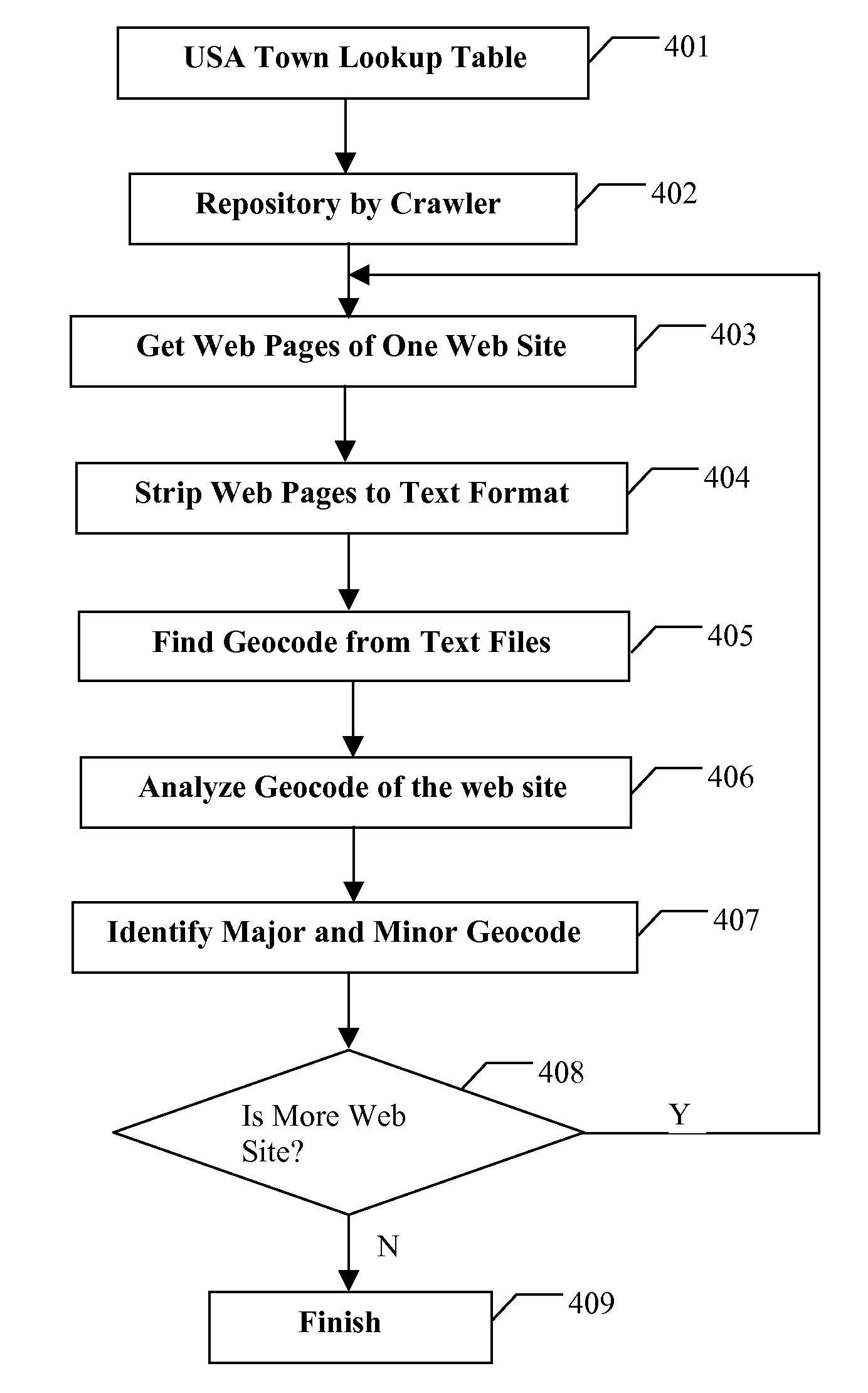[0009]One
advantage of configurations described herein is that they help to solve the problem of how to let a local
consumer reaching local web sites. Conventional web sites do not adequately solve this problem since conventional search engines treat each word in web pages as keyword. Geographic information is no exception. Thus, for a query such as “Restaurant Dayton NJ”, a conventional
search engine will find web pages containing the words “Restaurant”“Dayton” and “NJ”. A web page in Ohio may contain the three words and lead to a page that is not geographically located nearby to the user supplying those
search terms.
[0018]Embodiments of the invention significantly overcome drawbacks of conventional search engines and provide mechanisms and techniques for geographically indexing information using a unique
search engine architecture. Generally, the search engine configured in accordance with embodiments of the invention is capable of performing a web
crawling process to identify web pages of a web site. This can include traversing links originating from a seed web page to identify new web pages of the web site and stripping the content of web pages of the web site to a format containing only text. Some of the web pages of the web site may be geocoded. A geocoded web page can contain, for example, addressing information that can be used to either directly identify a physical location of a business or other entity associated with the web site. Alternatively, a geocoded web page containing information such as a
telephone number may be used to perform a manual or automated lookup operation to identify the physical location of an entity associated with the web site. The
system thus identifies a geocoded web page of a web site and identifies a geocode contained within content of the geocoded web page of the web site. The geocode indicates a physical location of an entity associated with the web site. The system also identifies at least one geocodable web page of the web site. The geocodable web page of the web site might be any page that does not contain
geocoding information such as an address but nonetheless is associated with the web site (e.g., has a URL that is within the same domain as the geocoded web page). The system then indexes content of the geocoded web page and content of the geocodable web page(s). The indexing includes associating the geocode contained or derived from or within content of the geocoded web page to the indexed content of the geocoded web page as well as to indexed content of geocodable web page to allow geographical searching of both the content of the geocoded and geocodable web pages.
[0019]In this manner, for a typical web site that has numerous pages that do not contain addressing information, the system of the invention will identify those pages (i.e., geocodable web pages) of the web site and will produce a geocode representing the location specified within the geocoded web pages (i.e., the those web pages the do contain an address of the entity associated with the web site). The system produces an index that associates the pages that did not contain addressing information to the geocode discovered on the pages the did contain addressing information, such that non-address containing pages can be geographically indexed according the geocode of those pages that do contain addressing information. Since the pages are related as being part of the same web site, the existence of the geographical information specified by the address of any page in the web site can be used to geographically associate to all pages of the web site within the index. Accordingly, the system of the invention allows a search provided by a user searching for pages containing content and that are located within a specific geographic location (e.g., a user supplied
ZIP code for example), to be applied to pages associated with that geographic location but that did not contain specific addressing information.
[0023]A crawler, geocoder, geosorter, georanker, geoindexer and geosearcher as described herein can be, for example,
computer software that can run in one or more computers, each of which has a memory encoded with a
software application providing such processes, and each including one or more processors capable of executing the application code of the crawler, geocoder, geosorter, georanker, geoindexer and geosearcher to provide corresponding respective processes for such components. The processor and memory are interconnected with an
interconnection mechanism such as a data
bus or other circuitry. The computer(s) can include a
network interface to receive queries. Each component may run in a single computer or a cluster of computers. As an example, the crawler, geocoder, geosorter, georanker and geoindexer may be run in computers in a search engine business or web portal. The geosearcher typically runs in a
data center and contains a number of
server computers for fast performance.
[0024]The method and system disclosed herein has major advantages in performing a local search compared with existing conventional apparatus and systems. It is more accurate because it analyzes the geographical relationship among web pages, not just one web page. It is much less expensive to implement than a conventional search engine because it organizes the large amounts of data into smaller subsets. It is also significantly faster since it searches a smaller geographically related
data set to find matches as opposed to searching an entire
database of all web pages regardless of geography.
 Login to View More
Login to View More  Login to View More
Login to View More 


